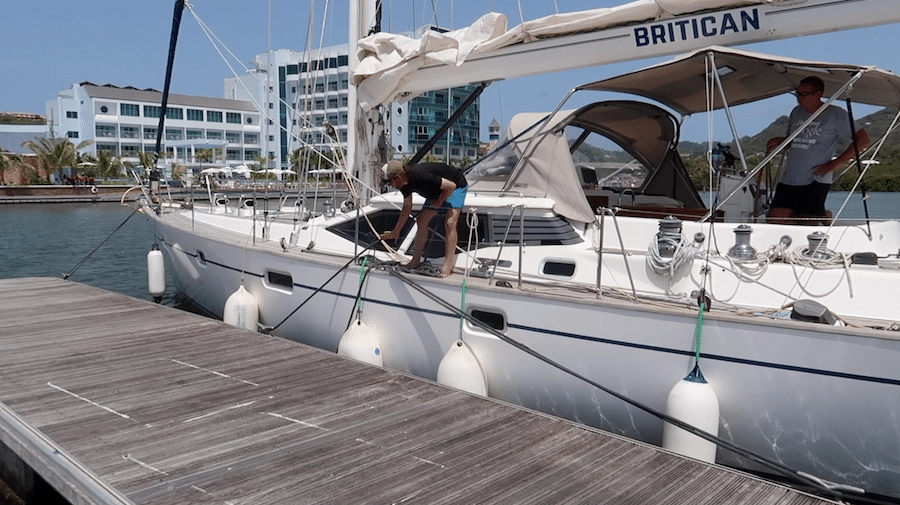New boaters often find success or failure in their sailing cruising dreams based upon their first few experiences, not with sailing (ironically) but with getting the boat in and out of the marina. Time after time, I’ve seen dreams shattered due to a bump, crash, and/or a full-on anxiety attack. If you can learn how to leave a dock, your ability to become a cruiser increases drastically.
And there is an easy way to leave a dock!
It doesn’t have to be stressful. There is no need for shouting or running around. Successfully leaving a dock is a process that anyone can learn and then practice over and over until they master it.
Watch the video, where Simon explains the eight steps to successfully leaving a dock, including a play-by-play demonstration and a paper cut-out explanation to really drill down into the process. Simon also provides the steps on how to reverse off a dock if going forward is not possible. Below, you’ll find a handy checklist to refresh your memory when it’s time for you to leave a dock.
If you like blueprints for success, check out all my sailing guides at my store or on Amazon.com.
How To Leave A Dock Video
How To Leave A Dock Checklist
1. Observe the wind and water state. Will the wind and tide push you onto the dock or away from it? Will natural forces push you forward or backward? Get an idea of how the wind and water will help or hinder you.
2. Based on your observations, Explain the plan to your partner or crew.
3. Prepare all your lines to slip from the boat. In other words, make sure no line is tied to the dock. The line should be tied to the boat cleat, through the fairlead around the dock cleat, and back to the boat. That way, you can untie the line on the boat and easily pull it back to the boat.
4. Line up your fenders so that the hull is protected. If you plan to take the bow forward, make sure there is a fender in the back corner. If you plan to reverse backward, ensure the bow has adequate fenders (Watch the full video to understand both procedures).
5. Engage the throttle so it’s just ticking over.
6. Turn the wheel as far away from the dock as possible. Doing this activity with a mid-aft spring will force the boat tightly to the dock.
7. Remove all three lines except the mid-aft spring, which includes the bow, stern, and forward spring.
8. When a crewmember is ready to release the last line, or the mid-aft spring, put the engine into neutral so the line can be easily released.
Once the line is back on the boat, put the engine forward and leave the dock.
Any Questions, Comments, or Feedback on How To Leave a Dock?
Please leave it below.
Would You Like To Practice Leaving A Dock with Simon?
Join us on the Britican Experience. Click the link for more information.




Check Out Other Sailing, Maneuvering & Mooring Related Articles and Videos
To get an overview of all our sailing, maneuvering, and mooring related articles and videos, start here: Sailing, Maneuvering & Mooring. Otherwise, check out one of these articles or videos:
- Stern To Med Mooring
- High Wind Sailing Techniques
- How To Tie Onto A Mooring Ball
- How To Leave A Dock
- Anchoring In Poor Holding Anchorages
- Anchoring In Storms
- Anchoring Complications – Picking Up Someone Else’s Anchor
- Sailing In Storms
- How To Pole Out Your Jib Downwind Sailing
- Sailing With A Gennaker
- Rigging, Sails & Reefing On A Sailboat
- Sailing Pre-Passage Checklist
Sorry, but it looks to me that you are doing it wrongly, although being successful. That line which you call a spring line is not in fact a spring. A spring line leads forward. Your explanation would be great if the line you use to pull the bow off the dock was a stern spring line.
Allow me some advice, forget my comment and keep doing things as you do, if the results are good.
Hey Francisco- I disagree- there are two springs- one going forward and one going to the stern side of the dock. My thoughts are that whenever you secure your boat when docking, you have to have a spring line to secure the boats movement both forward and backwards. Obviously pending what type of dock / marina you are in. But we have always secured two spring lines- one forward, one rear and a bow and stern line, for angular movement.
Reinhardt Koch, my disagreement is about the line used to bring the bow of the boat off the dock while unmooring. The following link provides a good explanation about my point although wrongly naming the lines, what they call a forward spring is in fact an aft spring and vice versa. https://www.boatus.com/magazine/2013/February/docking-with-spring-lines.asp
Good explanation on leaving the dock. Thanks
You are absolutely correct that getting out of tight berths is tricky! However, I did feel that your demonstration was an easy situation. What about Bows in, pontoon one side, boat other side and a strong current pushing you OUT towards the boats behind? (Beaulieu River!) Very little room or time for manoevre
Also a very useful technique is ‘springing off’ when the wind is pushing you on to the pontoon and no room to go forward. Fender the stern, put a running line amidships on the pontoon to the stern. Go into REVERSE and the bow has no place to go but out against the wind
Hey Lilias,
I’m the one in the video.
Yes you are right there are more difficult and dangerous situations.
This footage was filmed in St Lucia docket at Rodney Bay Marina.
A very secluded marina so no current, the wind was about 10kt on a starboard beam.
It was also the only marina in 2 months, as a result marina/docking footage is rare.
Simon gives, in my opinion, a good example with his paper boat to handle in different situations.
If you have any questions, don’t hesitate and reply.
Douwe
This is a great guide, video demonstrations like this are definitely the best way to teach beginners. I’ve subbed to your channel.
Thank you Larry 🙂
Hi,a
I just subscribed to your channel – really great videos! I think two manouvers are just as commom:
1. mooring to a slip between two boats – so to a short place, hence not possible to approach to the slip at a low angle.
2. you are on a berth between two boats alongside you, and the wind is pushing you on one of them while trying to leave the berth.
Best regards1
I use three cleats on both the starboard and port sides of the vessel, and from a cleat close to the stern to the dock in front of the boat, I run a spring line. I think it’s enough to secure my boat.
Sounds good to me James 🙂
Thank you! Getting ready for our first boating adventure and some individuals imply I’m stupid and stay home if I’m asking questions. You are so kind and helpful.
I got the same when I first started Valerie. Ignore them. In most cases, the people who talk down to new sailors don’t even sail themselves. There are loads of helpful people out there. Enjoy your journey! Kim